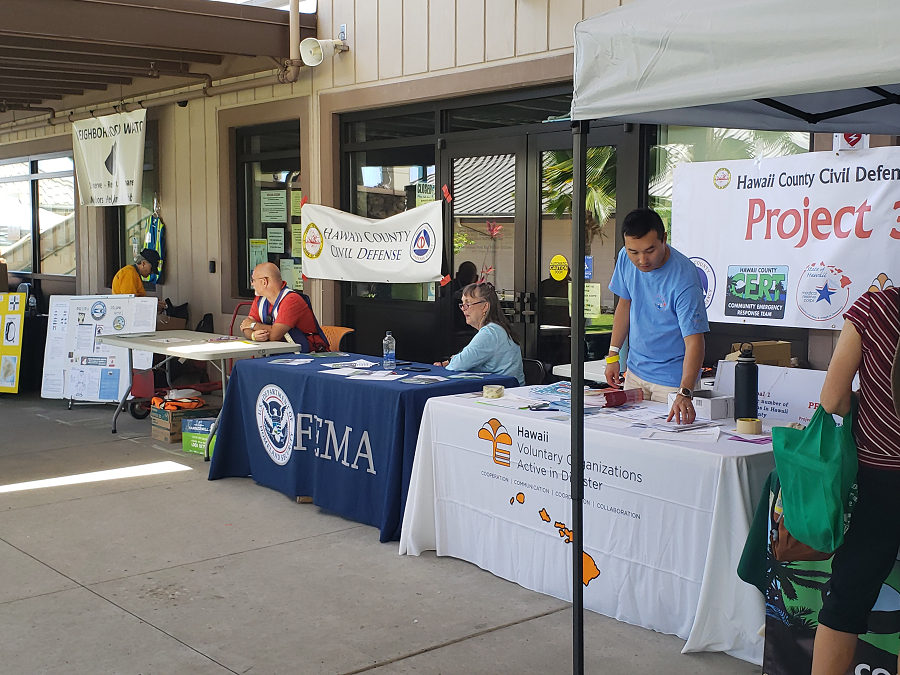
Hawaii County Civil Defense, which is responsible for Hawaii’s Big Island of Hawaii, hosted a Disaster Preparedness Fair last weekend. Held at the West Hawaii Civic Center, hundreds of people from across the island came to meet and mingle with more than 30 emergency response agencies. During 2018, Hawaii County saw multiple natural disasters and could be facing new threats in the coming weeks.
In 2018, Hawaii County, the largest county and island within the state island chain, suffered from not only a historic volcanic eruption, but from extensive wildfires and brushes with tropical cyclones. The 2018 Lower East Rift Zone eruption of Kilauea Volcano grabbed headlines last May, with active lava flows pouring across the Puna district in eastern Hawaii through to the fall. The eruption wiped-out the communities of Kapoho and Vacationland, destroyed a large part of the residential community Leilani Estates, and re-shaped the coastline of Hawaii Island. As the lava flows waned, tropical cyclones threatened the state and the island more than once. The first of an exceptionally busy hurricane season, Hurricane Hector, safely passed south of Hawaii Island. Prior to it’s arrival, Tropical Storm Warnings were up for Hawaii County and many beaches, roads, and ports were closed. After the early August brush with Hector, a more serious threat arrived later in the month arrival of Hurricane Lane. While a direct landfall did not occur on Hawaii Island, major impacts were felt. Hilo saw its wettest three-day period on record with 31.85″ of rain ; 15″ fell on August 24 alone, marking the fifth-wettest day in the city’s recorded history. Rainfall totals were highest along the volcanic slopes of the Big Island; 49.48″ fell in Waiākea-Uka near the city. while 52.02″ Mountain View. This made Lane the wettest tropical cyclone on record in the state of Hawaii, eclipsing the previous peak of 52″ during Hurricane Hiki in 1950. Tropical Storm Olivia was the next tropical cyclone to impact the region, however most if its impacts were felt on nearby Maui County. During the summer, several wildfires impacted the Big Island, including a 20,000 acre blaze near the village of Waikoloa on Hawaii’s west coast. More than 3,500 acres burned on the slopes of Mauna Loa inside Hawaii Volcanoes National Park. Dangerous gas emissions and ash were also dispersed on Hawaii, bringing about additional hazards to the island. Hawaii was also rocked by tens of thousands of earthquakes during 2018, all tied to the eruption event. Some of those earthquakes produce property damage, especially near Hawaii Volcanoes National Park which was closed last summer due to the eruption and quake threats.
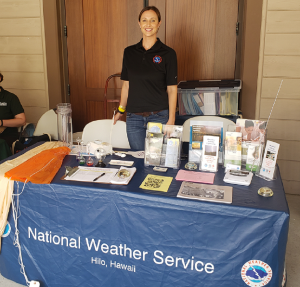
Hawaii County was in some form of emergency or disaster for most of 2018. On May 3, Hawaii Governor David Ige declared a State of Emergency for Hawaii as a result of the Kilauea eruption. On May 22, Hawaii County Mayor Harry Kim signed a Supplemental Disaster Proclamation. The Governor and Mayor issued additional proclamations, ending with the sixth mayoral declaration made on December 6, which extended the emergency proclamation another 45 days into the start of this year. Right now, there is no State of Emergency or Disaster Declaration in effect in Hawaii County, but that could change in the coming weeks, especially with the Central Pacific Hurricane Center calling for an above normal hurricane season in the basin that surrounds Hawaii.
Today, we asked @GovHawaii how coordination with state/local/federal agencies worked last year. With multiple tropical cyclone threats, earthquakes, flash floods, & an erupting volcano, the Aloha State was kept on its toes! #HIwx #HurricaneStrong? pic.twitter.com/AbBRC4NNXo
— the Weatherboy (@theWeatherboy) May 23, 2019
In addition to taking questions residents had about 2018 disasters, experts from a variety of local, state, and federal organizations provided insights and information to keep people safe for whatever natural disasters may come to the county/island next. While Kilauea Volcano stopped erupting last year and surface flows of lava have been absent from the island, USGS is monitoring an uptick in activity not only there, but in the much larger Mauna Loa volcano on the island too. While there have been more earthquakes in recent weeks, USGS does not believe there is any imminent threat of eruption from any volcano on Hawaii but they continue to monitor that should it change.
Also monitoring things for Hawaii are the meteorologists at the National Weather Service and Central Pacific Hurricane Center in Honolulu, Hawaii. While no tropical cyclones are threatening the state now, some extended guidance suggests that could change as the Fourth of July Weekend wraps up.
Officials from a variety of agencies are encouraging people to be ready for the next disaster, whether it be from hurricane, fire, earthquake, or volcano. Because of how isolated Hawaii is from the rest of the country, experts want people in Hawaii not only well prepared, but well stocked with supplies. Disruptions to utilities, communications infrastructure, or roads/bridges/ports may impede rescue crews and supplies from reaching people quickly. As such, people in Hawaii are urged to have at least two weeks worth of supplies on-hand now before any disaster materializes in the Aloha State.
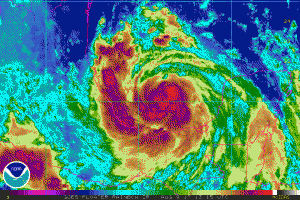
Around Hawaii and the Central Pacific Hurricane Basin it sits in, Hurricane Season runs the same time as it does in the Atlantic Hurricane Basin from June 1 to November 30 each year. By knowing what actions to take before, during, and after a storm’s arrival, you can increase your chance of survival.
Hurricanes aren’t the only danger from the tropics: while lacking the potent winds that hurricanes have, tropical depressions and tropical storms can be devastating too. The primary hazards from tropical cyclones (which include tropical depressions, tropical storms, and hurricanes) are storm surge flooding, inland flooding from heavy rains, destructive winds, tornadoes, and high surf and rip currents.
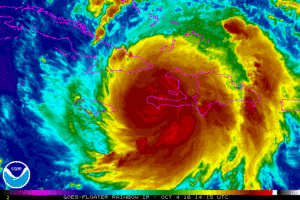
Storm surge is the abnormal rise of water generated by a storm’s winds. This hazard is historically the leading cause of hurricane related deaths in the United States. Storm surge and large battering waves can result in large loss of life and cause massive destruction along the coast. Storm surge can travel several miles inland, especially along bays, rivers, and estuaries. You don’t need to live on a beach to fall victim to storm surge flooding, as residents of New Jersey and New York learned in the wake of Hurricane Sandy.
Flooding from heavy rains is the second leading cause of fatalities from landfalling tropical cyclones. Widespread torrential rains associated with these storms often cause flooding hundreds of miles inland. This flooding can persist for several days after a storm has dissipated.
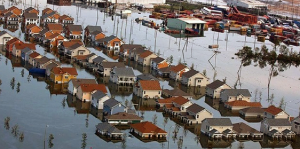
Winds from a hurricane can destroy buildings and manufactured homes. Signs, roofing material, and other items left outside can become flying missiles during hurricanes. Depending on local building codes, many homes may be built to only withstand winds of 100mph; major hurricanes have much higher winds than that and could lead to catastrophic destruction of even strong homes.
Tornadoes can accompany landfalling tropical cyclones. These tornadoes typically occur in rain bands well away from the center of the storm. While not as strong as tornadoes that form in supercell complexes, these tornadoes add an additional element of danger to a landfalling tropical cyclone.
Dangerous waves produced by a tropical cyclone’s strong winds can pose a significant hazard to coastal residents and mariners. These waves can cause deadly rip currents, significant beach erosion, and damage to structures along the coastline, even when the storm is more than a 1,000 miles offshore.
BEFORE
Before a hurricane or tropical cyclone threatens your area, you should be prepared and have a plan.
- Know Your Zone: Do you live in storm evacuation area? Find out if you live in a hurricane evacuation area by contacting your local government/emergency management office.
- Put Together an Emergency Supplies Kit: Put together a basic emergency kit, complete with fresh batteries, flashlights, radios, water, and non-perishable food. You should have at least 3 days worth of supplies in your kit and you should make sure items are fresh and/or working in every season.
- Check Emergency Equipment: Beyond flashlights, make sure other things such as generators and storm shutters are in good condition.
- Write or review your Family Emergency Plan: The best time to craft an emergency plan is when there is no emergency. In the calm before a tropical cyclone impact, preferably before or at the start of Hurricane Season, sit down with your family or close friends and decide how you will get in contact with each other, where you will go, and what you will do in an emergency. Keep a copy of this plan in your emergency supplies kit or another safe place where you can access it in the event of a disaster.
- Review Your Insurance Policies: Review your insurance policies to ensure that you have adequate coverage for your home and personal property. Remember: many policies have a waiting period to make claims; it may be necessary to get coverage well ahead of Hurricane Season to have effective coverage that season.
- Understand National Weather Service and National Hurricane Center advisories: Know the difference between watches and warnings and know what to do when any advisory for any tropical cyclone is issued for your area. Have a reliable way to get those advisories; the internet and your cellphone may not be working properly right before or during a tropical cyclone impact.
DURING
When a hurricane threatens your home, be prepared to evacuate if you live in a storm surge risk area. Listen to the guidance of local officials; if winds are strong enough, they may encourage you to evacuate too. Otherwise, they may recommend that you shelter in place if you aren’t in danger of flooding. Be sure to allow enough time to pack and inform friends and family if you need to leave your home.
- Secure your home: Cover all of your home’s windows. Permanent storm shutters offer the best protection for windows. A second option is to board up windows with 5/8 inch exterior grade or marine plywood, built to fit, and ready to install. Buy supplies before the hurricane season rather than waiting for the pre-storm rush.
- Stayed tuned in: Listen to NOAA Weather Radio or other trusted weather sources for the latest storm news.
- Follow instructions issued by local officials: Leave immediately if ordered to evacuate!
- If NOT ordered to evacuate:
- Take refuge in a small interior room, closet, or hallway on the lowest level during the storm. Put as many walls between you and the outside as you can.
- Stay away from windows, skylights, and glass doors.
- If the eye of the storm passes over your area, there will be a short period of calm, but at the other side of the eye, the wind speed rapidly increases to hurricane force winds coming from the opposite direction.
AFTER
Many dangers remain once a storm passes through.
- Follow local news: tune into NOAA Weather Radio or other trusted news sources for the latest updates and guidance on the storm,
- Return home only when told it’s OK: If you evacuated, return home only when officials say it is safe.
- Be extra-cautious when returning home: Once home, drive only if necessary and avoid flooded roads and washed-out bridges. If you must go out, watch for fallen objects in the road, downed electrical wires, and weakened walls, bridges, roads, and sidewalks that might collapse.
- Check your home for damage: Walk carefully around the outside of your home to check for loose power lines, gas leaks, and structural damage. Stay out of any building if you smell gas, if floodwaters remain around the building, if the building or home was damaged by fire, and/or if the authorities have not declared it safe.
- Use generators with caution: Carbon monoxide poisoning is one of the leading causes of death after storms in areas dealing with power outages. Never use a portable generator inside your home or garage.
- If power is out, only use battery operated lights: Use battery-powered flashlights and lanterns; do NOT use candles. Turn on your flashlight before entering a vacated building. The battery could produce a spark that could ignite leaking gas, if present.
NOAA’s Central Pacific Hurricane Center (CPHC) Director, Chris Brenchley, described to us today how his Honolulu team coordinates, collaborates, & even swaps staff with Miami-based National Hurricane Center (NHC) to keep America #HurricaneStrong?@NWSHonolulu pic.twitter.com/W1WM2EeXeC
— the Weatherboy (@theWeatherboy) May 23, 2019